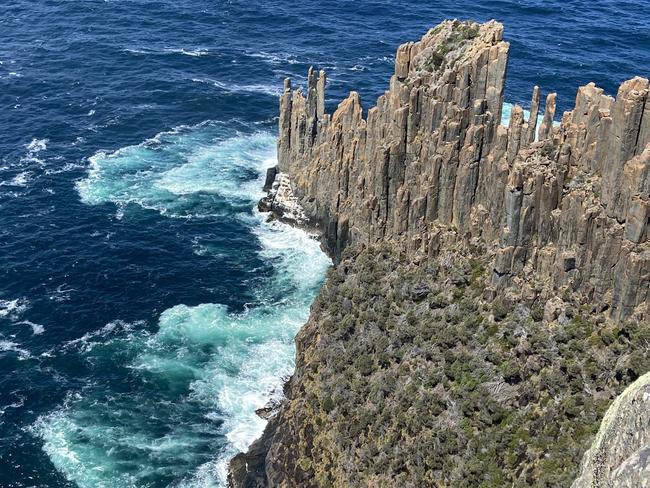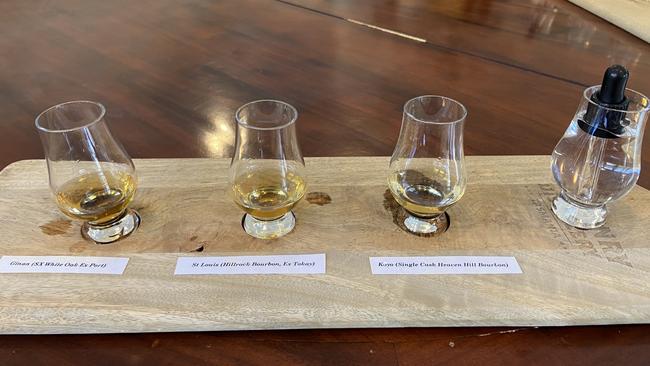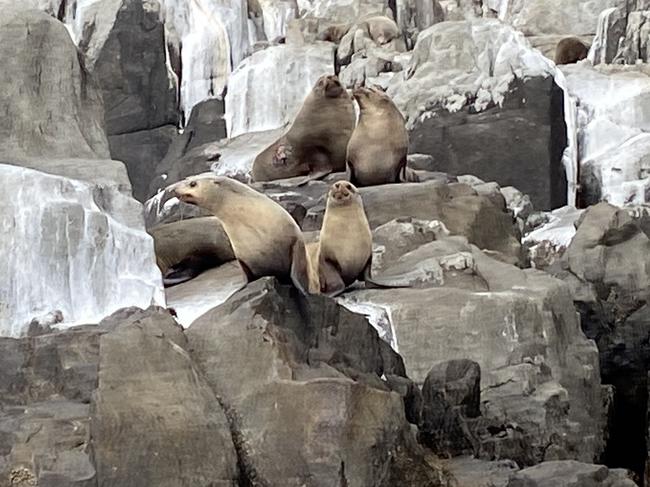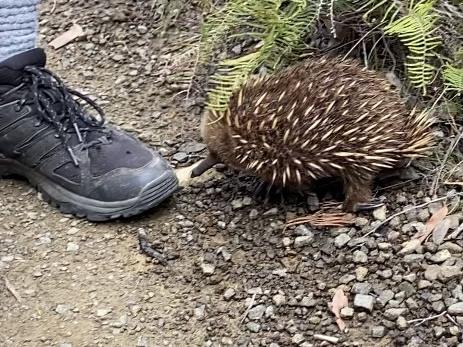Journalists generally aren’t great with numbers. At school most aced subjects like English and history but were lucky to scrape through in maths.
It’s just as well then that Three Capes is a pretty easy one for even those most mathematically challenged to work out. Or is it?
Southern Tasmania’s Three Capes Track is rapidly becoming a “must do” outdoors adventure – rivalling the famous Overland Track from Cradle Mountain to Lake St Clair in the state’s North West.
It has been brilliantly marketed as an iconic trek but the tourism guru that came up with the name Three Capes, couldn’t really count. Perhaps he or she was part journalist.
You see the walk only takes in two capes – Pillar and Hauy. The third one – Cape Raoul – juts out into the ocean a fair way off the beaten Capes track and there’s no direct path from Raoul to the other two, unless it’s by boat. Technically the walk should be called Two Capes And-one-from-a-distance Track. But that doesn’t quite have the same ring to it.
Many hikers have jumped at the chance to undertake the 48km walk, carting their food and gear on the four-day trek.

Another option is a three-day two-night experience, which takes in all three capes, involves about 45km of walking and you get to stay in 4-star accommodation, enjoy restaurant meals with bottles of local wine and an award-winning boat cruise.
Life’s An Adventure offers a Three Capes guided pack-free walk, including all transfers, from Hobart.
One of the beauties of the walk is that it allows flexibility to cater for varying degrees of fitness with shorter walk options (if a group numbers eight or more). Each day is treated as a separate itinerary and you are based at Stewarts Bay Lodge at Port Arthur. This means you are not locked into a “get from point A to point B” experience in a set time.
That flexibility was certainly a positive on day one when I joined seven others in the foyer of Hobart’s Grand Chancellor for a 7.30am start on a recent Friday. As we watched rain set in outside, a call from guide Chrissy Armstrong informed us of a bit of hiccup in misplaced keys for the company bus which would delay our start by about an hour.
She invited us to enjoy a free cuppa from the hotel’s restaurant and we chatted until Chrissy and fellow guide, her partner Craig Fardell, arrived with the bus.
Chrissy and Craig are experienced guides who arrived in Tasmania about two years ago. They love living in a state with so much world-class wilderness to show off.

That experience came into play after we arrived at Stewarts Bay Lodge and contemplated our next move. The itinerary said we were to walk out to Cape Raoul but a check on the weather forecast revealed gale-force winds sweeping in from the appropriately named Storm Bay and more driving rain. The exposed Cape was no place for hikers that day.
Instead we opt for the Day 2 itinerary – a 17.5km trek from Waterfall Bay to Fortescue Bay. We arrive at the walk start and take in the spectacular (and rare) sight of a waterfall thundering down the sheer mudstone cliffs to the water of the bay.
The display makes it clear to Chrissy and Craig that attempting the toughest of the walks on our itinerary is also fraught. While it might be more protected from the gale, there were a number of bridgeless streams to cross and there was no guarantee the largest would be passable.
Instead we walk along the clifftop path from the Waterfall Bay lookout to Devils Kitchen – an easy 2.6km stroll which offers impressive views of the thundering surf smashing into the mudstone cliffs. We spend only 40 minutes in the elements, but a number of the group are pretty soggy as we eat lunch at the Eaglehawk Neck Blow Hole.
We drive to Remarkable Cave to check the conditions. We can see the raging water in the distance through the tunnel of the cave but the tide is out so the waves are less remarkable than usual.

The gale, on the other hand, is quite something. Craig and I fight to stay on our feet as we face the storm at the Maingon Bay Lookout. Horizontal rain feels like shards of ice against our faces and we watch the wild sea. It’s cold and wet. It’s exhilarating.
Back on the bus, which is rocking in the wind, we call it a day in the hiking stakes. Most of the group choose to spend a couple of hours at the Port Arthur Historic Site but I opt for a shower and relax before a top-class meal at the historic site’s 1830 restaurant. The steak is delicious and local wines hit the spot.
Day 1 tally: bus keys -1, waterfalls 3, rain 37.9mm, walking 2.6km, strongest wind gust 115km/h, hot showers 10, perfectly cooked meals 10.
It’s a steady but reasonably gentle climb from the car park at the beginning of the walk to Cape Raoul the following morning. The group is in good spirits after a night snug in bed listening to rain on the roof and an excellent hot breakfast at Stewarts Bay Lodge.
The day is cool and overcast but the rain has stopped and the wind eased.
After five minutes, leader Chrissy halts us suddenly. “I might just give the ‘snake talk’,” she explains, as we wait for walkers to regroup. An impressively striped tiger snake was enjoying some sunlight on the track before the lead walkers arrived.
She helpfully explains to the suddenly nervous group that all snakes in Tasmania are venomous but are as eager to get out of the way of walkers, as vice versa. We continue on, waving our arms in exaggerated gestures, and even spot the end of a striped tail as our shy friend slithers under a rock as we pass.

After a steady 40 minutes we suddenly arrive at a lookout atop 100m cliffs with spectacular views of the Cape and Shipstern Bluff – Tassie’s famed big-wave break which draws surfers from across the globe.
Despite the storm, the conditions aren’t quite right for the type of swells which draw the wetsuit brigade to “Shippies”.
Our task ahead looks daunting, but the trek out to Cape Raoul is another 90 minutes or so and not difficult. A few showers have us changing layers a couple of times but the sun progressively takes over as the day wears on.
Cape Raoul is one of the iconic backdrops to Sydney-Hobart Yacht race finishes – as airborne photographers often get to capture the contrast of the sleek looking yachts against the raw, jagged dolerite cliffs of the coastline. To stand atop those cliffs is another experience altogether. The sheer size and ruggedness is so apparent, especially as huge waves crash against their base.
On the return home to our accommodation, we drop in on McHenry – Australia’s southern most whisky distillery – and sample their gins and whiskies. It’s an ideal way to ease the aches of the 4½ hour hike.

Day 2 tally: Capes 1, snakes 1, kilometres walked 16.93, spa baths 1, local wines several.
Our final day’s program is full. The talk over another excellent hot breakfast is whether to be worried about possible sea sickness on our Pennicott Wilderness Journeys Tasman Island Cruise in the morning. Ginger tablets are a popular option but they needn’t have worried. The Pennicott cruise boats are open to the air which helps keep travellers cool, and the experienced skippers are expert at manoeuvring through any sized swell.
We quickly make our way around to Waterfall Bay and take in the falls which are still crashing into the sea.

Suddenly, the skipper hears over the radio there may be some whales out to sea and he guns it out to another cruise boat about 3km away. We soon spot a spout about 50m ahead and then the skipper speculates there are a dozen or more whales around the boat … I can only see about four … but that’s enough.
We continue down the coast, past Cape Hauy and its Candlestick and Totem Pole formation – pillars of dolerite rising to cliff height. Within 20 minutes we stop at the bottom of Cape Pillar and crane our necks upwards to see the top of the tallest sea cliffs in the Southern Hemisphere rising a colossal 300m from the sea. It’s difficult not to feel small – our 11m boat dwarfed by their imposing form.
Back on shore we eat lunch on the bus to Fortescue Bay for the final part of our adventure – a four hour return walk out to Cape Hauy.
The day is still overcast but we are advised against putting on too many layers. It soon becomes apparent why as we steadily climb up through forest.

At one point one of our group casually says: “Oh did you guys see the echidna back there?” … What??? We double back and sure enough there’s a little echidna curled tightly into the dirt not 30cm from the track’s edge. Craig instructs as to stand still and we watch in quiet wonder as the little spiked ball of cuteness slowly emerges, snuffling around Craig’s feet before momentarily snuggling down between his boots and then slowly stepping over one and back into the bush.
We continue walking and within the hour we are perched high on the lookout 200m above the water overlooking the formations we’d seen earlier from the boat. The promised cuppa is a welcome break on our way back up the hill and the friendly banter is testament to the bonds formed over the three-day experience.
Day 3 tally: Capes 3, Whales 4, kilometres walked 10.38km; steps – lots and lots, baby echidnas 1, satisfied adventurers 8.
The author was a guest of Life’s an Adventure

MAKE A NOTE
Life’s an Adventure Three Capes Pack-free Walk.
■ A three-day guided walk experience staying two nights at Stewarts Bay Lodge starts at $1949 ($2049 peak season).
■ The package includes all meals, accommodation, transfers to and from Hobart and to and from all walking destinations. The meal allowance includes two restaurant meals plus local wines, and cooked breakfasts, lunches each day and hiking snacks.
■ Special rates are available for private groups of 12 participants.
For further information visit: lifesanadventure.com.au

Check out Airbnb’s latest: Where history meets slow travel bliss
Overlooking Australia’s oldest bridge in the historic village of Richmond, this convict-crafted accommodation offers a backstage pass to history – best enjoyed with a glass of wine in hand, writes Cas Garvey
Is this Bicheno’s dreamiest coastal outlook?
Perched on a sand dune overlooking the ocean, this East Coast retreat offers dazzling views, style and serenity. Add sun, wild swims and whale sightings – it’s clear Bicheno has never looked better